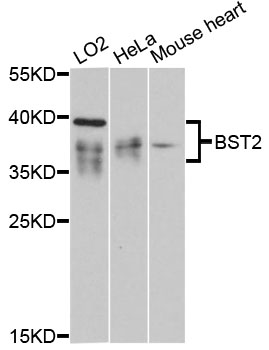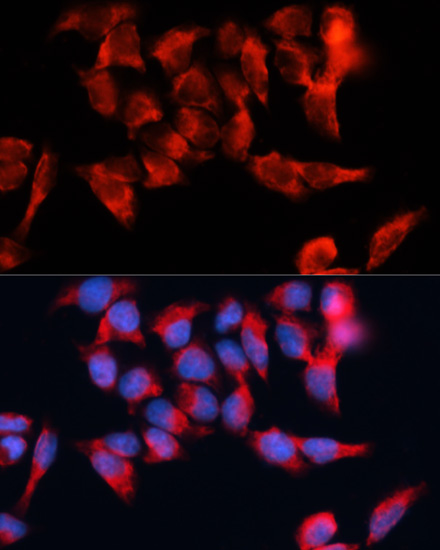Anti-BST2 Antibody (CAB12315)
- SKU:
- CAB12315
- Product type:
- Antibody
- Reactivity:
- Human
- Reactivity:
- Mouse
- Host Species:
- Rabbit
- Isotype:
- IgG
- Antibody Type:
- Polyclonal Antibody
- Research Area:
- Immunology
Description
| 抗体名: | Anti-BST2 Antibody |
| 抗体コード: | CAB12315 |
| 抗体サイズ: | 20uL, 50uL, 100uL |
| 申し込み: | WB IF |
| 反応性: | Human, Mouse |
| 宿主種: | Rabbit |
| 免疫原: | Recombinant fusion protein containing a sequence corresponding to amino acids 49-161 of human BST2 (NP_004326.1). |
| 申し込み: | WB IF |
| 推奨希釈: | WB 1:500 - 1:2000 IF 1:50 - 1:200 |
| 反応性: | Human, Mouse |
| ポジティブサンプル: | LO2, HeLa, Mouse heart |
| 免疫原: | Recombinant fusion protein containing a sequence corresponding to amino acids 49-161 of human BST2 (NP_004326.1). |
| 精製方法: | Affinity purification |
| ストレージバッファ: | Store at -20'C. Avoid freeze / thaw cycles. Buffer: PBS with 0.02% sodium azide, 50% glycerol, pH7.3. |
| アイソタイプ: | IgG |
| 順序: | NSEA CRDG LRAV MECR NVTH LLQQ ELTE AQKG FQDV EAQA ATCN HTVM ALMA SLDA EKAQ GQKK VEEL EGEI TTLN HKLQ DASA EVER LRRE NQVL SVRI ADKK YYPS SQDS S |
| 遺伝子ID: | 684 |
| Uniprot: | Q10589 |
| セルラーロケーション: | Apical cell membrane, Cell membrane, Cytoplasm, GPI-anchor, Golgi apparatus, Late endosome, Lipid-anchor, Membrane raft, Single-pass type II membrane protein, trans-Golgi network |
| 計算された分子量: | 18kDa/19kDa |
| 観察された分子量: | 35-40kDa |
| 同義語: | BST2, CD317, TETHERIN |
| バックグラウンド: | Bone marrow stromal cells are involved in the growth and development of B-cells. The specific function of the protein encoded by the bone marrow stromal cell antigen 2 is undetermined; however, this protein may play a role in pre-B-cell growth and in rheumatoid arthritis. |
| UniProt Protein Function: | BST2: IFN-induced antiviral host restriction factor which efficiently blocks the release of diverse mammalian enveloped viruses by directly tethering nascent virions to the membranes of infected cells. Acts as a direct physical tether, holding virions to the cell membrane and linking virions to each other. The tethered virions can be internalized by endocytosis and subsequently degraded or they can remain on the cell surface. In either case, their spread as cell-free virions is restricted. Its target viruses belong to diverse families, including retroviridae: human immunodeficiency virus type 1 (HIV-1), human immunodeficiency virus type 2 (HIV-2), simian immunodeficiency viruses (SIVs), equine infectious anemia virus (EIAV), feline immunodeficiency virus (FIV), prototype foamy virus (PFV), Mason- Pfizer monkey virus (MPMV), human T-cell leukemia virus type 1 (HTLV-1), Rous sarcoma virus (RSV) and murine leukemia virus (MLV), flavivirideae: hepatitis C virus (HCV), filoviridae: ebola virus (EBOV) and marburg virus (MARV), arenaviridae: lassa virus (LASV) and machupo virus (MACV), herpesviridae: kaposis sarcoma- associated herpesvirus (KSHV), rhabdoviridae: vesicular stomatitis virus (VSV), orthomyxoviridae: influenza A virus, and paramyxoviridae: nipah virus. Can inhibit cell surface proteolytic activity of MMP14 causing decreased activation of MMP15 which results in inhibition of cell growth and migration. Can stimulate signaling by LILRA4/ILT7 and consequently provide negative feedback to the production of IFN by plasmacytoid dendritic cells in response to viral infection. Plays a role in the organization of the subapical actin cytoskeleton in polarized epithelial cells. Belongs to the tetherin family. |
| UniProt Protein Details: | Protein type:Cell development/differentiation; Membrane protein, GPI anchor; Membrane protein, integral Chromosomal Location of Human Ortholog: 19p13.11 Cellular Component: apical plasma membrane; cell surface; cytoplasm; Golgi apparatus; integral to plasma membrane; membrane; multivesicular body; plasma membrane Molecular Function:metalloendopeptidase inhibitor activity; protein binding; protein homodimerization activity; signal transducer activity Biological Process: cell proliferation; cell-cell signaling; defense response to virus; humoral immune response; innate immune response; multicellular organismal development; negative regulation of cell growth; negative regulation of cell migration; negative regulation of plasmacytoid dendritic cell cytokine production; negative regulation of viral genome replication; positive regulation of I-kappaB kinase/NF-kappaB cascade; regulation of actin cytoskeleton organization and biogenesis; response to virus |
| NCBI Summary: | Bone marrow stromal cells are involved in the growth and development of B-cells. The specific function of the protein encoded by the bone marrow stromal cell antigen 2 is undetermined; however, this protein may play a role in pre-B-cell growth and in rheumatoid arthritis. [provided by RefSeq, Jul 2008] |
| UniProt Code: | Q10589 |
| NCBI GenInfo Identifier: | 1705508 |
| NCBI Gene ID: | 684 |
| NCBI Accession: | Q10589.1 |
| UniProt Secondary Accession: | Q10589,Q53G07, A8K4Y4, |
| UniProt Related Accession: | Q10589 |
| Molecular Weight: | |
| NCBI Full Name: | Bone marrow stromal antigen 2 |
| NCBI Synonym Full Names: | bone marrow stromal cell antigen 2 |
| NCBI Official Symbol: | BST2 |
| NCBI Official Synonym Symbols: | CD317; TETHERIN |
| NCBI Protein Information: | bone marrow stromal antigen 2 |
| UniProt Protein Name: | Bone marrow stromal antigen 2 |
| UniProt Synonym Protein Names: | HM1.24 antigen; Tetherin; CD_antigen: CD317 |
| Protein Family: | Bone marrow stromal antigen |
| UniProt Gene Name: | BST2 |



